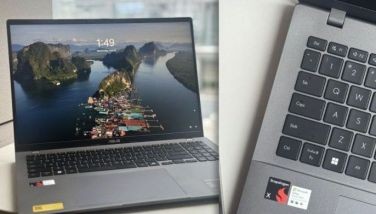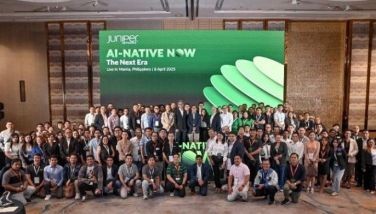Filling the gaps in early RP history

June 12, 2006 | 12:00am
Today is Independence Day… a day that once in my youth, we celebrated on the 4th of July owing to the fact that it was on that day when the Americans truly granted us Independence from their colonial rule and we have historic photos of President Manuel Roxas raising the Philippine Flag while the American flag was being brought down.
But then, I understand that because then President Diosdado Macapagal needed something from the Americans and didn’t get it, he moved this historic date to the present June 12… thus rehabilitating the aging Katipunero Gen. Emilio Aguinaldo who raised the Filipino Flag in his residence in Kawit, Cavite (Aguinaldo wasn’t given recognition because he ordered the killing of another Filipino hero, Andres Bonifacio). How many times have we said it here that a man’s house is his castle and therefore, he can raise any flag of any nation if he wants to? But then, it was the President of the Philippines who changed this and thus, it has been this way since.
This brings us to the question… whether history should be told as it is or can someone merely change history for his own ends. For this discussion, it is a generally accepted idea that Portuguese explorer Fernão Magalhães a.k.a. Ferdinand Magellan, under the employ of King Philip of Spain, discovered what is now known as the Philippine archipelago. Let me point out clearly that Magellan first discovered Homonhon and Limasawa in Leyte and then Cebu (Zebu), but there was no Philippines in those days.
But what is clear in the writings of Fr. Pigafetta is that they found Chinese silk and porcelain being traded in Cebu, which clearly tells you that the Chinese were already here and since we were supposed to be part of the Sri-Vishaya Empire, so too with the ancient Hindus. Therefore, the politically correct statement as far as Magellan’s discovery is concerned is that, he was the first European to discover this part of the then known world.
Last week was Portuguese Week in Cebu and the Embassy of Portugal in the Philippines, led by his Excellency João Caetano da Silva, held a lecture and the launching of the book, "The Portuguese Maritime Power, Rights and Enclaves in Asia; The Philippine Connection," by Prof. Ivo Carnerio de Sousa at the CAFA Theater of the University of San Carlos’ Talamban campus attended by many academics, including famous Cebuano historians Dr. Resil Mojares and Dionisio Sy.
What Prof. De Sousa told his audience virtually opened us to a new reality that Portugal was doing its own exploration around these islands even before — and a lot more after — Magellan came to Cebu. Prof. De Sousa’s book is a must-read for all Filipino historians because he tells us something that we’ve never heard or read before. No, sir, he is not trying to rewrite history, rather he is filling many blanks in Philippine history that we’ve not encountered in the history books in our schools. What a great revelation!
For instance, the Treaty of Tordesillas on June 7, 1494 virtually divided the unknown world between Spain and Portugal with the approval of the Holy See. Did you know that Magellan, in a previous expedition, had already come to the Moluccas, just south of Mindanao? In those days, Portugal had something that the Spanish didn’t have: cartographic maps of the so-called Spice Islands. Therefore, since he was a Portuguese, it is safe to assume that Magellan used Portuguese cartographic maps during his historic expedition that brought him to Cebu on March 16, 1521.
With the Treaty of Tordesillas, Prof. De Sousa said the Philippine archipelago fell under the jurisdiction of Portugal… but Magellan made his claim for the King of Spain who paid for his expedition. Thus, in 1750, Spain and Portugal signed the Treaty of Madrid whereby the Portuguese exchanged the Philippines for the South Frontier of Brazil, which gave Portugal control of Rio de la Plata. Again this is something we’ve never read in our history books. History tells us that Spain sold the Philippines to the United States for a measly sum of $20 million, but we never knew about this exchange deal between Spain and Portugal for Brazil!
Talking about rewriting history, we all know about the claim made by some Butuanons that a place called Mazaua was allegedly the site of the first Holy Mass instead of Limasawa Island off Southern Leyte. Well, Prof. De Sousa has another insight on this, which I’m sure puts an end to this endless debate and enrich our pre-Spanish history. It turned out that the ill-fated Magellan expedition ended Spanish exploration of these islands. But Portuguese navigators like João de Barros, Gaspar Correia, Diogo do Couto, Francisco de Castro and Antonio Galvão have been exploring Mindanao from 1520 to 1565 until the Spaniards resumed its conquest of the Philippines through another expedition led by Miguel Lopez de Legazpi.
Even as early as June 1970, Cebuano historian Dionisio A. Sy already wrote a book entitled "Butuan through the ages" where he already disproved that Mazau or Mazawa was the site of the first Mass because the naval latitude coordinates that Pigafetta used almost matched that of Limasawa in Leyte. Therefore, if Magellan never went to Butuan… who did?
Any of these Portuguese explorers I mentioned went to Mindanao, but the best bet is Antonio Galvao who circumnavigated the whole island. In fact, one Portuguese captain named João de Canha Pinto (who is also mistaken as João de Caminha) went to the island of Sirigao, which could very well be Siargao today, and had a blood compact with the King there.
Ambassador Da Silva gave me two books, "As Filipinas Na Historiograficda Portuguesa Do Seculo XVI" or Philippines in Portuguese XVIth Century Histobiography, and Discussing the First Portuguese Maps with the Philippines by Ivo Carnerio de Sousa and Jose Manuel Garcia, and in a map made between 1535 and 1538, Butuan is named Butan or Butuão. I’ll elaborate on this in our future columns. Spain didn’t even know Butuan existed!
Portuguese Week ended with the unveiling of the newly renovated Magellan’s Cross, which was a project funded by the Portuguese Embassy through the Calouste Gulbenkian Foundation in coordination of the Cebu Parks and Playgrounds and the Cebu City Historical and Cultural Commission. Mrs. Therese Gonzalez led the project. It was more than just as simple celebration of Portuguese Week; it was a rekindling of friendship between the two nations as Cebu City Mayor Tomas Osmeña and Vice Mayor Michael Rama both stressed.
More importantly, this week filled the gaps of our history, which was long denied to Filipinos; after all, we were under Spanish rule for more than 400 years. We shall be writing about this in future columns with the hope that the National Historical Institute would put it in our history books.
For e-mail responses to this article, write to vsbobita@mozcom.com. Bobit Avila’s columns in The Freeman can also be accessed through The Philippine STAR website (www.philstar.com). He also hosts a weekly talkshow, "Straight from the Sky," shown every Monday, 8 p.m., only in Metro Cebu on Channel 15 of SkyCable.
But then, I understand that because then President Diosdado Macapagal needed something from the Americans and didn’t get it, he moved this historic date to the present June 12… thus rehabilitating the aging Katipunero Gen. Emilio Aguinaldo who raised the Filipino Flag in his residence in Kawit, Cavite (Aguinaldo wasn’t given recognition because he ordered the killing of another Filipino hero, Andres Bonifacio). How many times have we said it here that a man’s house is his castle and therefore, he can raise any flag of any nation if he wants to? But then, it was the President of the Philippines who changed this and thus, it has been this way since.
This brings us to the question… whether history should be told as it is or can someone merely change history for his own ends. For this discussion, it is a generally accepted idea that Portuguese explorer Fernão Magalhães a.k.a. Ferdinand Magellan, under the employ of King Philip of Spain, discovered what is now known as the Philippine archipelago. Let me point out clearly that Magellan first discovered Homonhon and Limasawa in Leyte and then Cebu (Zebu), but there was no Philippines in those days.
But what is clear in the writings of Fr. Pigafetta is that they found Chinese silk and porcelain being traded in Cebu, which clearly tells you that the Chinese were already here and since we were supposed to be part of the Sri-Vishaya Empire, so too with the ancient Hindus. Therefore, the politically correct statement as far as Magellan’s discovery is concerned is that, he was the first European to discover this part of the then known world.
Last week was Portuguese Week in Cebu and the Embassy of Portugal in the Philippines, led by his Excellency João Caetano da Silva, held a lecture and the launching of the book, "The Portuguese Maritime Power, Rights and Enclaves in Asia; The Philippine Connection," by Prof. Ivo Carnerio de Sousa at the CAFA Theater of the University of San Carlos’ Talamban campus attended by many academics, including famous Cebuano historians Dr. Resil Mojares and Dionisio Sy.
What Prof. De Sousa told his audience virtually opened us to a new reality that Portugal was doing its own exploration around these islands even before — and a lot more after — Magellan came to Cebu. Prof. De Sousa’s book is a must-read for all Filipino historians because he tells us something that we’ve never heard or read before. No, sir, he is not trying to rewrite history, rather he is filling many blanks in Philippine history that we’ve not encountered in the history books in our schools. What a great revelation!
For instance, the Treaty of Tordesillas on June 7, 1494 virtually divided the unknown world between Spain and Portugal with the approval of the Holy See. Did you know that Magellan, in a previous expedition, had already come to the Moluccas, just south of Mindanao? In those days, Portugal had something that the Spanish didn’t have: cartographic maps of the so-called Spice Islands. Therefore, since he was a Portuguese, it is safe to assume that Magellan used Portuguese cartographic maps during his historic expedition that brought him to Cebu on March 16, 1521.
With the Treaty of Tordesillas, Prof. De Sousa said the Philippine archipelago fell under the jurisdiction of Portugal… but Magellan made his claim for the King of Spain who paid for his expedition. Thus, in 1750, Spain and Portugal signed the Treaty of Madrid whereby the Portuguese exchanged the Philippines for the South Frontier of Brazil, which gave Portugal control of Rio de la Plata. Again this is something we’ve never read in our history books. History tells us that Spain sold the Philippines to the United States for a measly sum of $20 million, but we never knew about this exchange deal between Spain and Portugal for Brazil!
Talking about rewriting history, we all know about the claim made by some Butuanons that a place called Mazaua was allegedly the site of the first Holy Mass instead of Limasawa Island off Southern Leyte. Well, Prof. De Sousa has another insight on this, which I’m sure puts an end to this endless debate and enrich our pre-Spanish history. It turned out that the ill-fated Magellan expedition ended Spanish exploration of these islands. But Portuguese navigators like João de Barros, Gaspar Correia, Diogo do Couto, Francisco de Castro and Antonio Galvão have been exploring Mindanao from 1520 to 1565 until the Spaniards resumed its conquest of the Philippines through another expedition led by Miguel Lopez de Legazpi.
Even as early as June 1970, Cebuano historian Dionisio A. Sy already wrote a book entitled "Butuan through the ages" where he already disproved that Mazau or Mazawa was the site of the first Mass because the naval latitude coordinates that Pigafetta used almost matched that of Limasawa in Leyte. Therefore, if Magellan never went to Butuan… who did?
Any of these Portuguese explorers I mentioned went to Mindanao, but the best bet is Antonio Galvao who circumnavigated the whole island. In fact, one Portuguese captain named João de Canha Pinto (who is also mistaken as João de Caminha) went to the island of Sirigao, which could very well be Siargao today, and had a blood compact with the King there.
Ambassador Da Silva gave me two books, "As Filipinas Na Historiograficda Portuguesa Do Seculo XVI" or Philippines in Portuguese XVIth Century Histobiography, and Discussing the First Portuguese Maps with the Philippines by Ivo Carnerio de Sousa and Jose Manuel Garcia, and in a map made between 1535 and 1538, Butuan is named Butan or Butuão. I’ll elaborate on this in our future columns. Spain didn’t even know Butuan existed!
Portuguese Week ended with the unveiling of the newly renovated Magellan’s Cross, which was a project funded by the Portuguese Embassy through the Calouste Gulbenkian Foundation in coordination of the Cebu Parks and Playgrounds and the Cebu City Historical and Cultural Commission. Mrs. Therese Gonzalez led the project. It was more than just as simple celebration of Portuguese Week; it was a rekindling of friendship between the two nations as Cebu City Mayor Tomas Osmeña and Vice Mayor Michael Rama both stressed.
More importantly, this week filled the gaps of our history, which was long denied to Filipinos; after all, we were under Spanish rule for more than 400 years. We shall be writing about this in future columns with the hope that the National Historical Institute would put it in our history books.
BrandSpace Articles
<
>
- Latest
- Trending
Trending
Latest
Trending
Latest
Recommended































